-

人教版高中语文必修2《赤壁赋》说课稿3篇
[教学反思]人教版高中语文必修二第三单元安排了《兰亭集序》《赤壁赋》《游褒禅山记》三篇古代山水游记散文,它们借游赏之事,探索生命的意义、治学的道理。师者,所以传道、授业、解惑也。高中的教材选用的都是历史经典名篇,每一篇都闪烁着儒道释等百家光辉的思想。编者要老师传道的意图很明显。即非如此,看着这些影响历代、影响世界的如日月之耀眼光华的伟大思想就躺在我们的教科书里,又如何能不讲呢?所以,我将本课的教学重难点拟定为:帮助学生建立积极的生死观,掌握多角度看问题的正确的思想方法。当然,也让学生领会了融写景、抒情、说理于一炉的大家手法。整堂课各教学环节,环环相扣,过渡自然,读、思、议、写训练到位,而且全部围绕“生死观”展开,如一篇形散神不散的散文。
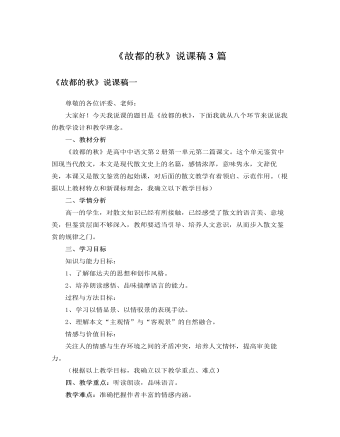
人教版高中语文必修2《故都的秋》说课稿3篇
请一位朗诵水平较好的学生,有感情的朗读课文12自然段,其他同学完成一项任务:这一段可否去掉?为什么?学生思考、圈画、交流、讨论,然后小组发言,其他小组补充,教师从旁予以点拨,引导学生进一步明确作者的思想情感。明确:作者要创造一种文化氛围,于自然气息之外再添一重文化气息,与“故都”题旨暗合。从行文章法上看,这里是宕开文笔,纵横议论,显出深厚的文化底蕴和开阔的思路。这一段采用议论,通过古今中外的引证,说明感秋处处有,中国文人最突出,而秋“深味”非在中国北方莫属,这其实还是为了突出故都之秋。(设计意图:提高学生探究的能力,充分把握本文的教学内容,深刻体悟作者的情感,了解作者对秋的礼赞情感,从而突破教学难点。)
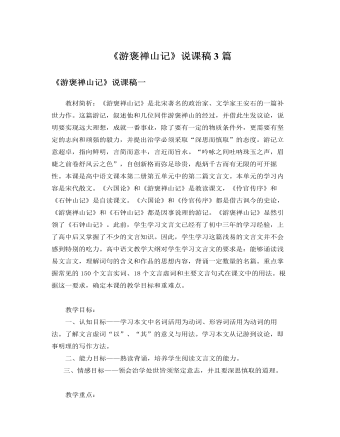
人教版高中语文必修2《游褒禅山记》说课稿3篇
学法指导:高一学生对文言文阅读已具备了一些基础知识和积累,但对如何学习文言文,还是一个新课题,因此教师应引导学生掌握学习方法,运用已有的知识框架同化新信息,建立新的智能,逐步走向独立学习的境界。一、引导学生利用课文注释,使用工具书自己翻译,必要时教师进行点拨、解难,培养自学能力。二、告诉学生翻译文言文要遵循的原则。三、调动学生思考、讨论、交流的积极性,教师适时点拨,培养学生发现问题、解决问题的能力。四、提示学生反复诵读课文,体会文章所阐述的道理。五、鼓励学生及时归纳学习文言文的方法,注意积累文言文知识。教学程序:教学本课可安排2课时。第一课时:1、导入新课:首先给学生介绍毛泽东的七绝诗《为李进同志题所摄庐山仙人洞照》:“暮色苍茫看劲松,乱云飞渡仍从容。天生一个仙人洞,无限风光在险峰。”学生通过诵读领会了“无限风光在险峰”一句的含义。随后因势利导,引出课题,指出今天我们要学习的王安石的《游褒禅山记》,就含有类似的深邃哲理。
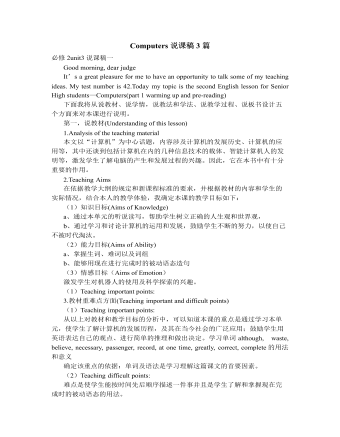
人教版高中英语必修2Computers说课稿3篇
一. 教材分析1. 本单元的中心话题是“计算机(Computers)”,内容涉及计算机的发展历史,计算机的应用等。本节课是该单元的第一课时,我将Warming up, Pre-reading and Comprehending这四部分整合为一节精读课。其中。Reading部分是题为WHO AM I?的文章,以第一人称的拟人手法介绍了计算机发长演变的历史和计算机在各个领域的应用,其主旨是表达计算机的发展变化之快以及在生活中用途之广。而Warming up部分以图片的形式展现了计算机的发展历程;Pre-reading中的问题和排序分别是为了预测语篇的内容和测试学生对计算机历史了解的情况;Comprehending则通过各项练习训练学生的阅读技能,从而加深对文章的理解。可见这几部分是一个有机的整体。2. 教学目标:1) 语言目标:重点词汇及短语:abacus, calculate, calculator, PC, laptop, PDA, robot, analytical, technological, universal, mathematical, artificial, intelligent, network, explore, in common, as a result.重点句子:a. My real father was Alan Turing, who in 1963 wrote a book to describe how computers could be made to work, and build a “universal machine” to solve any mathematical problem.
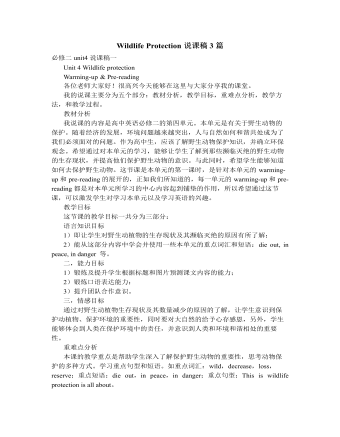
人教版高中英语必修2Wildlife Protection说课稿3篇
When it comes to the students’ studying methods, I'd like to introduce my Ss first. The Ss have a good command of basic language points. They’re interested in learning English, and they take an active part in English class, so they will have fun in autonomous, cooperative and inquiry learning. I will just serve as a guide, showing them the way to explore how to make more progress in their English learning.Now it’s time for the most important stage of this lesson. My teaching procedures are arranged as follows:Step1.Leading-in (3 minute)Play a video of a wide variety of wildlife to introduce my topic. Step2. Speaking (12 minutes)We will use our textbook Page25. Let the Ss fast read the short paragraph to warm up. Ask them to talk about the report on some endangered wildlife in China with the dialogue patterns on the screen. Lastly, I will invite some groups to demonstrate their dialogues about saving wildlife in China.Step3.English play (3 minutes)Watch another video in praise of their excellent performance just now. It’s about Jack Chen’s(成龙)and Yang Ziqiong’s wildlife protection.Step4. Listening (twice 13 minutes)This time, I’ll ask the Ss to fill in the blanks of the monologue of the 2 movie stars above. Step5.Discussion (3 minutes)Which would you like to choose to wear, clothes made of cotton, artificial leather or animal skins? Why ?Step6. Summary (3 minutes)1. If there were no wildlife, there wouldn’t exist human beings. If the buying stops, the killing can, too.2. Animals are our friends. To love animals is to love ourselves. Stop hunting, killing and destroying wildlife.3. Let’s live in harmony with all the living things in the world. Step7. Music appreciation (3 minutes)Let the Ss appreciate the song Earth Song by Michael Jackson. Last but not the least, I will show you my blackboard design.
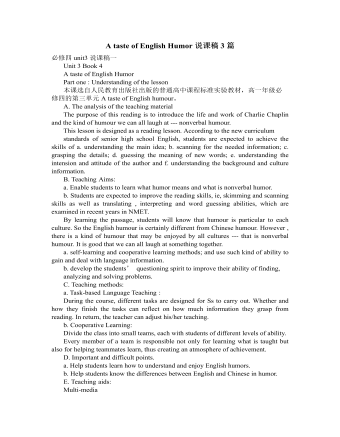
人教版高中英语必修4A taste of English Humor说课稿3篇
Then I would ask them to think of a funny English or Chinese and tell it to partners. While telling stories, they can use expressions and some acting to help make the story funny. 5 minutes would be given to do this.Those stories they told there will be the material for their writing. Soletting them tell it at first is helpful. And they can make a difference between telling a funny story and writing it down. Generally speaking, it is difficult forstudents to write well because they don’t know what to write and how to write. Asking them to tell their own stories at first can help them come up with what to write.After their telling, I would invite someone to share his/her story with all of us and I would write it down on the blackboard.This example story would be used as a sample to illustrate the format of funny story. Different from a story from teacher or textbook, a story from students can obviously become a interesting material to draw students’ attention.Then I would ask the whole class to put this story into several parts. It might be a little bit difficult for them. So I would ask them to find out whether all the sentences are necessary. After delete some sentences, there are 6 sentences left behind. Then they can easily put them into three parts. After interaction with students, I would teach them the right terms for each part and conclude the format of funny story.This step is the key and difficult point in my lesson. So I mainly usetask-based teaching method in this part and the task for students was divided into several stages. With the separated difficult level, students can find there are usually three parts in writing. They can also learn to write without the unnecessary parts in the process of analyzing. And then I wouldn’t rush to tell them the right terms to them directly. Instead, I would ask them to name them by their own. A confused mind is better for acquiring knowledge.While-writing:Then I would give students 7 minutes to write down this story, without other requirements.With all the preparations in pre-writing, students’ difficulties were cleared. So it would be much easier for them to write down the story within 7 minutes. There are no other requirements because students’ first writing is actually a drafting. It would be revise and edit several times later. Writing, as a skill
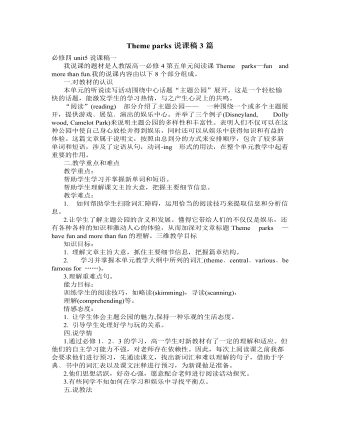
人教版高中英语必修4Theme parks说课稿3篇
The oldest and the most popular park in the worldenjoy the exciting activities thereget close to the life-size cartoon characters like Mickey Mouse and Donald Duck Step 3 Pre-reading1.What do you suppose a theme park is ?2.What do you think you can see in a theme park?(1.It is a kind of amusement park which has a certain theme – that the whole park is based on. 2.buildings, castles, statues, rare animals and birds, and so on.) Step 4 Reading ----- Theme Parks –---- Fun and More Than Fun1.Predict : Read the title and the pictures on P. 34 and PredictWhat is the meaning of the title “Theme Park – Fun and more than fun”?(The title means that theme parks are fun to visit, but that they can also be educational and can offer useful information.)2.Skimming Fast read and answer:What activities can we take in a theme park?Amusement park: Bumper car Merry-go-round slide bungee jumping Free-fall rides Horror films Pirate ship Ferris wheel roller coaster3.Scanning Read again and you will find various theme parks are mentioned in the passage . Then what are they ?Theme parks: Sports theme park History theme park Culture theme park Marine or Ocean theme Park Future park Science theme park Disneyland4.Careful reading and find the main idea of each paragraph:THEME PARKS---- entertaining/ educationalPara.1 Traditional parks are places to go for relaxation and to have time away from our busy lives.Para.2 Theme parks are different They’re large and full of things to do, see and buy.Para.3 Theme parks are built around a single idea or theme. One example is a sports park.Para.4 Another kind of theme park is historical more and cultural and can be educational.Para.5 Disneylandwas the first theme park. It is based on the fantasy life and characters of Disney’s films.Para.6 Some examples of educational theme parks include sea world parks and science parks.
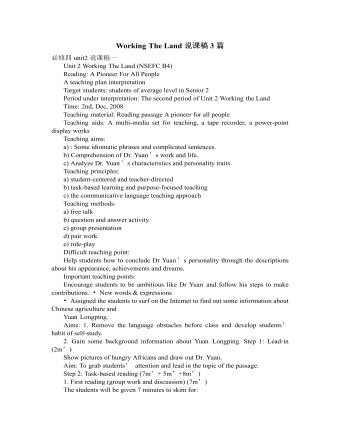
人教版高中英语必修4Working The Land说课稿3篇
Knowledge objectives:(1) to make Ss grasp the usage of words, expressions and sentence structures: statistics, struggle, thanks to, rid of, some patterns for persuasion, the “ing” form as subject and object;(2)to use learnt knowledge to persuade sb.Ability objectives:(1) to develop Ss’ reading skills(skimming, scanning, word guessing);(2) to improve Ss’ speaking, communicating and cooperating skills.Emotional objectives:to make Ss know the contribution of Yuan,and learn his spirit and his simple life time.Teaching important and difficult points:(1) some words, expressions and sentence structures mentioned above;(2)the content of the text;(3)training their reading and speaking skills.Teaching methods: CLT, TBLT,QT.Learning strategies: CLS, QLS, TBLS.Teaching procedures:Step 1 lead-in: (1) teacher plays a piece of recent news from CCTV about the harvest of the super hybrid rice, and ask students whether they know Yuan or not, and talk about him and his contribution.(2)Brain storm: let Ss describe Yuan in their minds including his appearance, his living condition and so on.Step 2 fast reading tasks:(1)teacher introduces Yuan and super hybrid rice(2)make Ss read the text as fast as possible with questions. Such as: what’s the general ideaof this passage? What’s Yuan’ dream? (skimming and scanning skill)Step 3 intensive reading tasks(1)let Ss read the text silently, find topic sentence of each paragraph and draw the difficult sentences and the knowledge what they don’t understand.(words guessing)(2)teacher and Ss talk about the important words, expressions and sentences together, and ask Ss to retell the content of the text.(summarizing and paraphrasing)(3)teacher summarize this part.(4) read again following the courseware.
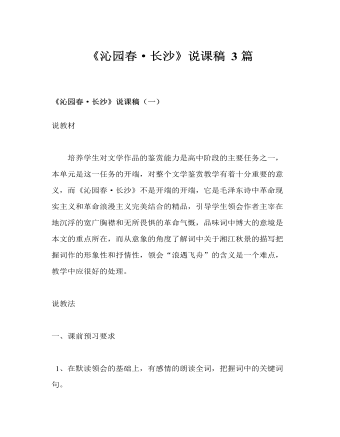
人教版高中语文必修1《沁园春·长沙》说课稿3篇
4、学习全词:(1)背景介绍,让学生看课文中的年代,然后让学生回忆1925年的毛泽东的情况,老师适当提示,让学生了解其背景。(出示幻灯片)(2)学生自由朗读,结合注释和背景理解诗词。(3)师生共同理解全词①先让学生齐读前三句,思考正确的语序,并用正常的语序解释。②品味第三到第十句,这里是教学的一个重点,要让学生先读,再理解,在此基础上训练学生的想象能力。③分析上阙中的最后三句。④小结上阙。提出了一个问题“谁主沉浮”让学生在文中找内容回答,然后转入下阙内容的分析。⑤分析下阙内容,回答“谁主沉浮”的问题,突出本文主旨5、描绘诗词形象:学生用自己的语言把上阙的内容生动地描绘出来。6、欣赏学生优秀作品。(根据时间具体而定,也可以作为课后作业)
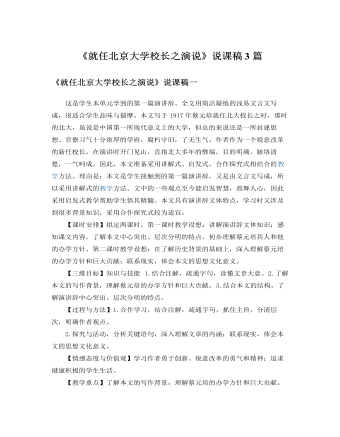
人教版高中语文必修2《就任北京大学校长之演说》说课稿3篇
(三)教学重、难点1、教学重点:结合课文,了解演讲辞针对性强、条理清楚、通俗易懂、适当的感情色彩等特点。2、教学难点:深入理解文章内涵,联系现实,体会本文的现实意义二、说学情高中学生在初中阶段已经接触过演讲辞了,对演讲词的特点已经有了一些基本的知识,因此本轮的教学应该让他们在此基础上有所提高。本文是学生在高中阶段第一次接触演讲辞,有必要让他们了解演讲辞的特点及课文如何体现这些特点的。随着年龄的增长,生活阅历的增加,高中学生正逐渐形成自己对世界、对人生的看法,蔡元培先生的这篇文章能很好地激发他们对当前的高中学习和未来的大学生活进行思考。此外,学生对北大的历史及蔡元培先生作这番演讲的时代背景了解不深,应作出补充说明。
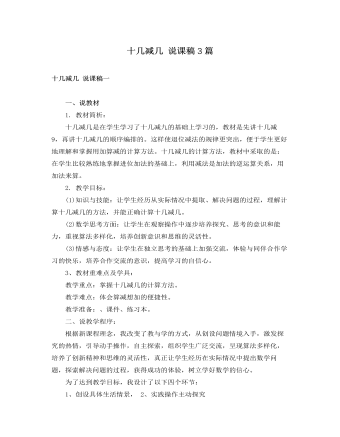
人教版新课标小学数学一年级下册十几减几 说课稿3篇
得到13-8=这个算式后,我让小朋友们想办法,“13-8怎么算?你是怎样想的?把你的想法告诉你小组的同学们。”由于我是用讲故事的形式引出这一问题的,因此在计算13-8时,小朋友们就被迫要自己想办法去计算,而不能光借助情境图去直接数出得数。这并不阻碍算法的多样化,相反更好地实现了算法多样化的目的,真正让学生成为了数学学习的主人。为了增加这堂课的趣味性,我有意将学生说出来的各种算法分别以他们的名字来命名,这样一来,学生兴趣盎然,都积极投入到了寻找算法的思考活动中来了。在寻求多样化的过程中,充分发挥了学生学习的主体性,培养了学生的创新精神,让每一个学生都能体验学习的成功。学生们在思考、讨论中可能会出现这样几种算法:
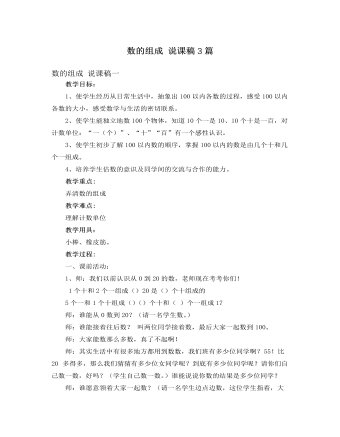
人教版新课标小学数学一年级下册数的组成 说课稿3篇
一、说教材分析教材分析:本部分内容是在学生认识了认数的第一阶段—20以内各数认识的基础上,扩展到认数的第二阶段—100以内各数的认识。本阶段的数概念不仅是学习100以内数计算的基础,也是认识更大的自然数的基础。它在日常生活中有着广泛的应用,因此必须使学生切实学好。在分析教材的基础上,灵活的运用教材,我认为开始的主题图,如果10只一群地出示,虽然有利于学生估数,但这样学生能很快地10只10只地数出羊群只数是100,在后面数100个物体的个数时,就会受其影响而10个10个地数,这样的数法,要在学生会逐个数数的基础上自然生成,其实,它比一个一个地数要高一个层次,数数单位由“一”变成了“十”,不利于学生把100以内的数逐个数出来,因此,我把主题图的出示放在了一个一个数物体之后。
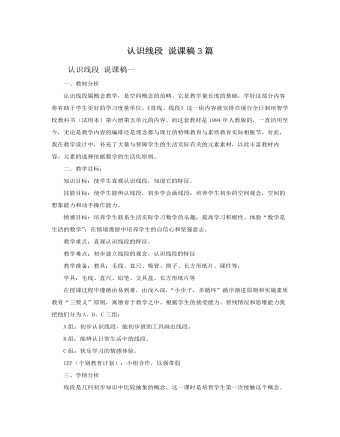
人教版新课标小学数学二年级上册认识线段 说课稿3篇
一.创设情境,解决问题。(一)直观认识1.请每个同学举起手中的毛线。说说你的毛线和其他同学有什么不一样。(学生会观察到有长短,颜色,粗细的不一样。)设计这个环节是为了让学生先找出线段的非本质特征。只有去掉了非本质特征,学生才能更明确到记住线段的本质特征。)2.请每个同学在认真观察,说说你的毛线和其他同学的有什么是一样的。这个环节学生最基本能发现手中的毛线是直的。(二).讲解概念1.通过直观的认识后,由教师讲解线段这个概念:像我们刚才手中这一条直直的毛线,就可以看做是线段。(这句话的讲解中,教师要突出直直的,这是线段的最基本特征,还有一个词是是看做是,数学的是严谨的,不能说这条毛线是线段,并让学生也举起毛线和老师一起说说这句话。)

人教版新课标小学数学四年级下册折线统计图说课稿3篇
三、制作统计图教师:事先我们一起搜集了这几年中我们班同学家庭拥有计算机的情况,并制成了统计表,请谁来介绍一下。(学生利用事先制成的统计表介绍数据)如果请你将它制作一份折线统计图,你有信心完成吗?小组讨论:你认为在制图时应做哪些工作?有什么注意点?(学生小组讨论后交流)在交流中,教师顺应学生回答,并相应介绍折线统计图各部分名称:(1)横轴:一般用于标明日期的前后;(2)纵轴:标明数据,反映单位长度表示的数据大小,一般最高数据比统计到的最高数据稍高一些;(3)制表日期和单位。学生独立在练习之上尝试练习。教师指名演示,同学互相评价并改正。统计分析:从这张统计图上你可以获得哪些信息?学生相互交流,也可以提问请同学回答。

人教版新课标小学数学五年级上册用字母表示数说课稿3篇
一、说教材:用字母表示数是人教版小学数学五年级上册第四单元的教学内容。在学习本单元之前,学生已经接触过一些用字母表示运算律,对简单实际问题中的基本数量关系熟悉了,这些都是学生理解本单元所学知识的重要基础。同时本单元知识又是学生进入代数知识学习的入门知识,是学习方程的基础。二、说教学目标和重难点:(一)目标1、理解用字母可以表示数,能用含有字母的式子表示简单的数和运算定律,初步学习用代数符号语言进行表述交流。2、经历把简单的实际问题用含有字母的式子进行表达的抽象过程,发展符号感。3、在解决问题中体会数学与生活的联系,体会代数符号表示实际问题中数量关系的概括性和简洁性,从而进一步感受学习数学的价值。(二)重点难点:理解用字母表示数的含义,能用含有字母的式子表示简单的数量关系。正确地用含有字母的式子表示运算定律。

人教版新课标小学数学五年级下册因数和倍数说课稿3篇
(4)判断中进行教学内容的递深,形成了反思——学习——强化的整个学习过程。在学生做出“6是倍数”的正确判断之后,并不简单换章,而是以此为契机“教学找一个数的因数”以谈话导入,形成知识相互的联系与区别,“谈话:必须说清谁是谁的倍数,谁是谁的因数。所以6可能是某些数的倍数,也可能是某些数的因数,那我们就来找一个数的因数。你能找出36所有的因数吗?”(5)讨论互评,自主学习放手让学生学习找一个数的因数,从无序到有序,从自寻到互学,请学生板书,学生评价,“提问:你是用什么方法找到一个数的因数,可以介绍给大家吗?还有其他方法吗?”1×36=36 36÷1=362×18=36 36÷2=183×12=36 36÷3=124×9=363 6÷4=96×6=36 36÷6=6(6)自主不失指导,掌握不失总结如:提问:5为什么不是36的因数?(因为36÷5不能整除,有余数)

人教版新课标小学数学六年级上册扇形统计图说课稿3篇
三、情感与态度目标教学重点:在合作讨论的过程中体会数据在现实生活中的作用,理解扇形统计图的特点,并能从中发现信息。教学难点:能从扇形统计图中获得有用信息,并做出合理推断。二、学情分析本单元的教学是在学生已有统计经验的基础上,学习新知的。六年级的学生已经学习了条形统计图和折线统计图,知道他们的特点,并具有一定的概括、分析能力,在此基础上,通过新旧知识对比,自然生成新知识点。三、设计理念和教法分析1、本堂课力争做到由“关注知识”转向“关注学生”,由“传授知识”转向“引导探索”,“教师是组织者、领导者。”将课堂设置问题给学生,让学生自己收集信息、分析信息,自主探索、合作交流,参与知识的构建。2、运用探究法。探究的方法属于启发式教学,探究学习的内容以问题的形式出现在教师的引导下,学生自主探究,让学生在课堂上多活动、多思考,自主构建知识体系。引导学生收集资料,获取信息并合作交流。

人教版新课标小学数学二年级上册统计 说课稿3篇
统计是一种数学思想,也是认识客观事物常用的一种方法。让学生学习统计,要引导他们经历收集、整理数据的过程,精力把整理出来的数据用图表形式表现出来的过程,经历对统计的数据进行分析、判断的过程,从中理解并掌握一些有关统计的基础知识和基本技能,学习解决实际问题。(一)新的课程标准要求我们的数学课程应体现基础性、普及性和发展性。要强调从学生已有的生活经验出发,要使学生学有价值的数学,这些内容要有利于学生主动地进行观察、实验、猜测、验证、理解与交流等数学活动。(二)本课的教学通过学生积极参与数学活动,合作交流,力求体现人人学有价值的数学,体现数学就在我们的身边,与我们的学习生活紧密相联,体会统计的目的和意义,掌握统计的方法,体验数学学习的乐趣。

人教版新课标小学数学一年级下册前后 说课稿3篇
前后是一年级下册第1单元位置中的内容,包括了上下、前后、左右、位置的知识。《数学课程标准》要求老师应该充分利用学生已有的生活经验,随时引导学生将所学的数学知识应用到生活中去,解决身边的数学问题,了解数学在现实生活中的作用,体会学习数学的重要性。对于这一内容的学习,学生有丰富的生活经验积累,在教学中想努力激活学生的相关经验,安排了让学生在多个实践活动观察、操作、想像、思考、游戏、说说等活动中体验前后顺序。考虑到一年级小朋友的年龄特点,我对教材作了比较大的调整,利用跟着笑笑去动物园看运动会把各个教学环节各项活动串联起来,使小朋友在体验探索前后的知识时有更大的动力和积极性,同时,采用漂亮的画面和动物来增强小朋友的兴趣好奇心和探索的积极性。

人教版新课标小学数学一年级下册平面图形的拼组 说课稿3篇
第三板块:夯实基础 发展技能检测是实施课堂优化教学的重要手段。因此,本节课的第三板块我设计了课堂目标检测,检测中以闯关形式设计了五个活动:即第一关:快乐填一填。第二关:动手剪一剪。第三关:用心拼一拼。第四关:仔细数一数。第五关:神奇拼一拼。检测中前三关,重抓基础知识的落实,后两关注重学生技能的培养,以及用数学的能力,符合低年级儿童年龄特点,我充分利用了学生争强好胜,乐于竞争的心理,以争夺智慧星的小组合作赛形式进行检测。既提升了学生自主强化知识的兴趣,又培养了学生集体主义观念。以上是我对《平面图形的拼组》一课设计理念的剖析与阐述,当然,教学是一门缺憾的艺术。所以,不足之处还请各位前辈提出宝贵意见!谢谢大家!





















